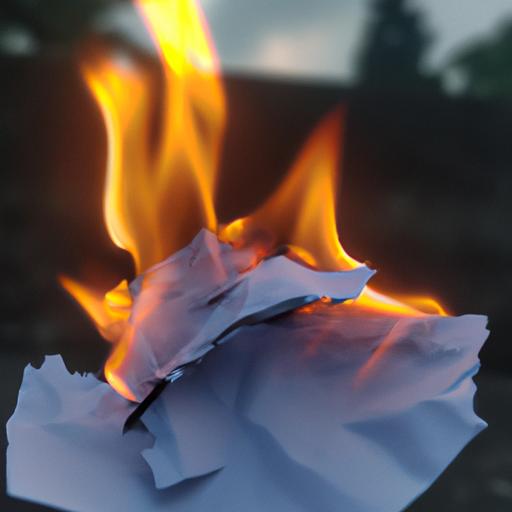What Temp Does Paper Burn: Understanding the Temperature Range of Paper Burning
Table of Contents
As a ubiquitous material used in our everyday lives, we often take paper for granted. Whether we’re using it to write, print, or wrap things, we rarely think about what happens when paper is subjected to extreme heat. In this article, we’ll explore the temperature range at which paper ignites and burns, the chemical composition of paper, and the combustion process of paper.
The Chemical Composition of Paper

Before we delve into the temperature range at which paper burns, it’s essential to understand the chemical composition of paper. Paper is made up of a combination of cellulose fibers and a matrix of lignin, hemicellulose, and other organic compounds. The cellulose fibers are the main component of paper and are responsible for its strength and flexibility.
When paper is subjected to heat, the cellulose fibers begin to break down, releasing volatile organic compounds, such as carbon dioxide, water, and carbon monoxide. These compounds react with oxygen in the air, producing heat and light, which results in the burning of paper.
The composition of paper plays a significant role in the burning process. For example, paper that contains a high percentage of lignin, such as newsprint, burns more readily than paper made from pure cellulose fibers.
The Ignition Point of Paper
The ignition point of paper is the temperature at which it begins to burn. This temperature varies depending on the type of paper and its composition. On average, paper ignites at around 451°F (233°C), which is why many books and films use the title “Fahrenheit 451” as a metaphor for censorship and the suppression of ideas.
However, the ignition point of paper can be much lower if the paper is exposed to a heat source for an extended period, as in the case of a lit cigarette left on a piece of paper. In such cases, the heat from the cigarette can cause the paper to ignite at temperatures as low as 220°F (104°C).
Factors such as the thickness of the paper, the humidity in the air, and the presence of flammable substances can also affect the ignition point of paper. It’s essential to handle paper with care, especially when exposed to heat sources, to prevent accidental fires.
The Combustion Process of Paper
When paper reaches its ignition point, it enters the combustion process. Combustion is a chemical reaction that occurs when a fuel, such as paper, reacts with oxygen in the air, releasing energy in the form of heat and light. The combustion of paper involves a series of chemical reactions that occur in three stages: ignition, flaming combustion, and smoldering combustion.
During the ignition stage, the heat from the heat source causes the volatile organic compounds in the paper to break down and release gases. These gases react with oxygen in the air, producing heat and light. As the temperature increases, the paper begins to emit smoke, and the flames become more intense.
The flaming combustion stage is the most visible stage of the combustion process. This stage is characterized by the presence of flames as the paper burns. The cellulose fibers in the paper rapidly break down, releasing more volatile organic compounds that react with oxygen, producing more heat and light.
The smoldering combustion stage occurs when the paper is no longer in direct contact with the heat source, but it continues to burn. During this stage, the paper burns slowly, producing little heat and light. The temperature of the paper decreases, and the combustion process eventually comes to an end.
The Temperature Range of Paper Burning
The temperature range at which paper burns varies depending on the type of paper and its composition. As we’ve mentioned earlier, paper ignites at around 451°F (233°C). However, the temperature range of paper burning can vary significantly depending on factors such as the thickness of the paper, the humidity in the air, and the presence of flammable substances.
For example, thin and dry paper, such as tissue paper or tracing paper, burns at relatively low temperatures. In contrast, thicker and more complex paper, such as cardboard or glossy paper, requires higher temperatures to burn.
It’s essential to note that burning paper at high temperatures can be dangerous and can lead to fires. It’s crucial to observe safety precautions when burning paper, such as ensuring that the paper is not in contact with any flammable substances and that the temperature is within a safe range.
The Temperature Range of Paper Burning
The temperature range at which paper burns varies depending on the type of paper and its composition. On average, paper burns at temperatures between 440°F (227°C) and 480°F (249°C). However, as mentioned earlier, the ignition point of paper can be much lower if exposed to a heat source for an extended period.
The temperature range at which paper burns is influenced by several factors, including the type of paper, its thickness, and the presence of flammable substances. For example, paper that has been coated with a flammable substance, such as wax or oil, will burn at a lower temperature than uncoated paper.
The humidity in the air can also affect the temperature range at which paper burns. In humid conditions, paper will burn at a lower temperature than in dry conditions. This is because the water vapor in the air absorbs some of the heat produced during the combustion process, reducing the temperature at which the paper burns.
Safety Precautions When Burning Paper
Burning paper can be dangerous if not done correctly. It’s essential to observe safety precautions when burning paper to prevent accidental fires and injuries. Here are some safety tips to keep in mind when burning paper:
-
Only burn paper in a well-ventilated area. Burning paper produces smoke and fumes that can be harmful if inhaled.
-
Use a metal container with a lid to burn paper. This will prevent the paper from spreading and causing a fire.
-
Never leave burning paper unattended. Always keep an eye on the paper to prevent it from igniting other materials.
-
Avoid burning large quantities of paper at once. This can cause the fire to become uncontrollable.
-
Always have a fire extinguisher or a bucket of water nearby when burning paper.
It’s recommended to burn paper at a temperature range of 450°F (232°C) to 480°F (249°C). Avoid burning paper at temperatures above 500°F (260°C) as this can cause the release of toxic gases and increase the risk of fire.
In conclusion, while paper may seem like a harmless material, it can be dangerous when exposed to extreme heat. Understanding the temperature range at which paper burns, its chemical composition, and the combustion process is essential to handling paper safely. Always observe safety precautions when burning paper to prevent accidental fires and injuries.

